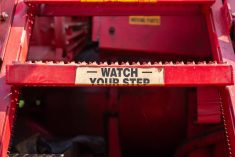A couple we’ll call Harry, 74, and Anne, 72, have been farming in central Manitoba for four decades and would like to retire. They have 1,600 acres — 600 for grain and the remainder for pasture and hay. Their children, two sons and two daughters, have careers away from the family farm. The problem: pay off the debt, and plan for retirement income.
Harry and Anne are still recovering from severe operating losses related to BSE two decades ago. They’ve downsized their beef herd from 100 cows to just 20 and have suffered from recent low crop yields. The farm earns just $30,000 a year.
Read Also

Gentle treatments for pain in the neck
Heading toward year-end, people unknowingly tense up against the cold and busyness, causing neck pain that can often be treated with appropriate support and gentle mobility, athletic therapist Kathlyn Hossack says.
“It’s a case of a currently unprofitable farm with good capital,” say Don Forbes and Erik Forbes of Forbes Wealth Management in Carberry, Man, who worked with the couple.
Harry has been working full time off the farm to generate additional cash flow to service farm debts of $245,000 on a home mortgage, $40,000 on a trailer loan, $4,850 to the Canada Revenue Agency and $26,000 on credit card debt.
The farm has $2.7 million worth of real estate. Harry and Anne could sell, pay their bills and retire. “They have to do it,” Erik says. “If they don’t, creditors could force a sale and that could be at an inappropriate time.” The first move is to develop a plan.
The couple should aim to pay income tax in a range of 26 to 33 per cent each year rather than defer the maximum amount of income until death where, through the estate, it would be taxed at 50 per cent or more, Don says. They are each eligible for the $1,000,000 Personally Owned Farm Land Capital Gains tax exemption. They can also exempt their personally owned home and one acre, say $600,000.
The solution is to sell. One quarter with an estimated market value of $490,000 and an original price of $28,000 has a nominal capital gain of $462,000. The credit will cut the tax to zero on this sale. However, for a year, there would be a loss to the Old Age Security clawback and some provincial tax payable, Erik says.
With $420,000 is available for debt management, $70,850 can be used to pay off credit card, Canada Revenue Agency and trailer debt; $250,000 can be used to pay off the mortgage. The balance can be invested in Tax-Free Savings Accounts and anything left over could go to an ordinary taxable investment account, Don explains. That takes care of immediate problems.
The remainder of the farm with an estimated market value of $1,610,000 and a book value of $128,000 has a capital gain of $1,482,000. Harry and Anne would have a remaining Farm Land Capital Gains Exemption of $1,482,000, subject, of course, to some provincial tax payable, loss of Old Age Security for the year when the gain is taken and the Alternative Minimum Tax.
After paying off creditors and some taxes, Harry and Anne would have perhaps $2 million in remaining assets, most of it in cash, given that they can only put $63,500 each into new TFSAs. Some of the remaining assets could go to their non-farming children. If the transfer to the children is to be in the near future, it could be at a low purchase price to provide them a tax-free transfer.
It would be possible for the parents to take a zero per cent promissory note on the land. That would protect the parents’ future retirement cash flow if any of the inheriting children were to get into financial difficulties through insolvency or divorce. In that case, creditors or an estranged spouse could seek to capture farm assets, but they would have to pay the parents before their claims would be considered.
“This plan to clear the family farm of debts, to provide potential money for the children, and to boost the incomes that Harry and Anne will have is simple and workable,” Erik says. “There are a few hurdles, such as the sale of the land, but we have priced the property conservatively. Moreover, they will keep their farm house and an acre of land and could, in future, sell that too in order to complete a move to town. Our solution takes care of their financial problems and lays a foundation for transferring wealth to the kids. It is simple, solid, and effective.”














